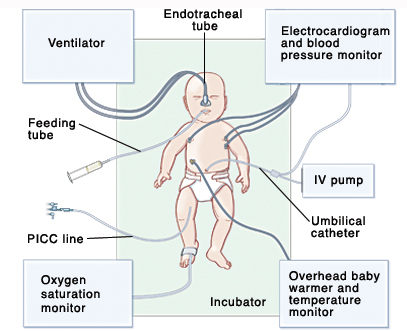Equipment in the NICU
Equipment in the NICU
These devices are often used while a baby is in the NICU (neonatal intensive care unit):
The incubator is the clear plexiglass box that makes up your baby’s bed. This enclosed space protects the baby from temperature changes. A radiant warmer over the bed may be used instead of an incubator to keep the baby warm. A cloth cover can be placed over an incubator to keep out noise and light.
A cardiorespiratory monitor keeps track of the baby’s heartbeat and breathing. It’s attached to the baby’s skin with three leads (sensors). These are held in place with a gel that’s gentle to the skin.
A pulse oximeter measures the level of oxygen in the baby’s blood. It’s attached to the skin with a sensor taped to the baby’s hand or foot. It works by shining a light through the baby’s hand or foot.
A blood pressure monitor may be a smaller version of the blood pressure cuff used on older children and adults. Or an arterial catheter (tiny tube inserted in an artery) may be used to monitor blood pressure.
A temperature probe measures the baby’s body temperature. It’s attached to the skin surface.
An intravenous line (IV) is a catheter (small, flexible tube) inserted into a vein. It’s used to give the baby fluids, nutrition, and medicines.
An umbilical arterial catheter (UAC) or umbilical venous catheter (UVC) is placed in the artery or vein at the stump of the umbilical cord. It’s used to give the baby medicines, fluids, and nutrition. It’s also used to draw blood for lab tests. Because there are no pain nerves in the umbilical cord, putting the line in and maintaining it causes the baby no pain. But there is a higher risk of complications with an umbilical catheter than with an IV.
Other equipment
A feeding tube (also called a gavage tube) goes through the mouth or nose into the stomach. It is used to feed the baby milk or formula.
CPAP (continuous positive airway pressure) machine delivers air or oxygen through tubes in the nostrils. It uses low, continuous pressure to keep the lungs inflated.
An endotracheal tube (ETT) goes through the baby's mouth or nose into the windpipe. It is used with a respirator or ventilator to send air directly to the lungs.
A respirator or ventilator may be used to help the baby breathe. These machines are attached to an ETT.
A peripherally inserted central catheter (PICC) or a percutaneous central venous catheter (PCVC) may be inserted in a central (large) vein. This catheter is used to give the baby fluids, nutrition, and medicine.
Updated:
August 14, 2018
Reviewed By:
Freeborn, Donna, PhD, CNM, FNP,Image reviewed by StayWell medical illustration team.,Lee, Kimberly G., MD, MSc, IBCLC
